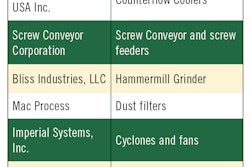
Our customers around the world want to understand what happened throughout the U.S. crop year and how that impacted the quality of the U.S. grains available for them to buy. With the U.S. Grains Council’s Corn Harvest Quality Report and Corn Export Cargo Quality Report — and through the face-to-face meetings that help present them to customers — we are helping U.S. agriculture maintain its premium brand in the global marketplace.
While price remains an important factor in buying decisions, it is not the only thing buyers consider. Particularly when faced with issues like quality concerns with corn from competitors or delivery issues due to logistical problems in South America, these quality reports give the Council good, hard data — not just anecdotes — to market U.S. quality and reliability.
These quality reports that come out each year soon after harvest concludes have become a key component of the Council’s strategy to promote U.S. corn overseas. Every winter and spring, the Council organizes and hosts rollout conferences for the new editions across the globe during which time USGC staff members and farmers representing USGC member organizations give detailed information on the reports’ findings and answer customers’ questions directly.
By pairing these two reports with face-to-face meetings that allow for personalized education and consulting, the Council is helping to improve customer perception of U.S. corn and build demand for the commodity.
Bringing the report abroad: the Middle East and North Africa
One of the first presentations of this information last year was in Cairo, Egypt, where USGC Senior Director of Global Programs Cary Sifferath along with USGC Regional Director of the Middle East and Africa Hesham Hassanein presented the findings to more than 80 buyers and end users from the region.
U.S. market share of Egypt’s corn imports have varied widely, from almost nothing during the 2012/2013 marketing year to more than 1.2 million metric tons (47 million bushels) in the 2014/2015 marketing year. Ukraine, Brazil and Argentina remain major competitors in this growing market.
In addition to hosting the conference, Sifferath and Hassanein presented the reports individually to key customers in their offices. By doing this, the Council enhanced the relationship between U.S. producers and Egyptian buyers of U.S. corn, building the local industry’s confidence in U.S. corn quality and demonstrating that the Council is a leader at providing reliable, transparent and timely market information.
Bringing the report abroad: Japan
In Japan, the 2014/2015 report rollout activities were part of an annual Corn Outlook Conference, an activity designed to keep customers in that mature market informed and to deepen ties between U.S. corn producers and the Japanese livestock producers who buy their products.
More than 160 Japanese buyers, traders and end users attended the 2014 conference to hear a panel of U.S. farmers and market experts present a detailed assessment of the U.S. supply and demand situation, key policy factors influencing the evolution of U.S. agricultural trade policy, and the U.S. corn market outlook for 2015.
Iowa corn producer Greg Alber traveled to the conference to represent U.S. producers and fielded questions about U.S. farmers’ planting intentions, the choice between genetically modified (GM) and non-GM varieties, and the potential impact of softening oil prices on U.S. ethanol production.
Having U.S. farmer-members attend these rollouts is invaluable to engaging customers and building the ongoing relationships that are essential to doing business in many Asian countries.
When farmers can’t attend in person for a quality report meeting, customers still hear from producers directly through an accompanying series of videos USGC produces to chronicle the growing conditions in the U.S. Corn Belt. The videos, available online at https://www.youtube.com/usgrainscouncil, track a small group of U.S. farmers throughout the crop year.
Bringing the report abroad: Latin America
Given the integration of the North American markets, buyers in Latin America are among the most responsive customers to shifts in the United States. Timely and accurate information is valuable to sophisticated buyers, and the USGC corn quality reports have found eager audiences in the Latin American feed and livestock industries.
For example, Peru had surging U.S. sales in 2015, filling its import quota for U.S. corn of 709,260 tons (27.9 million bushels) in the first seven days of the year. The country finished the 2014/2015 marketing year out strong as the fifth-largest U.S. export destination, setting a historic record of more than 2.5 million tons (98.4 million bushels).
After a standstill of corn imports in the previous few years, these figures were a refreshing change and created a timely backdrop for the Council’s presentation to Peruvian buyers of the 2014/2015 Corn Harvest Quality Report results.
Members of a USGC team held face-to-face meetings with prominent buyers and end users of U.S. corn to help them plan appropriately for the coming year. The Peruvian buyers and end users asked numerous questions about farming in the United States and how low corn prices would impact U.S. planting decisions in 2015. Getting these questions answered directly by members of the U.S. grain value chain helped them have greater confidence in the United States’ ability to meet their corn demand.
The Council’s dual corn quality reports also scored points with Mexican buyers. During a four-city swing last year, two farmer-delegates provided the U.S. growers’ perspective, which was of great interest to partners in Mexico. Buyers asked these farmers about the possibility for mycotoxins, information about planting intentions and price expectations for next year.
2015/2016’s quality reports
When we roll out these reports, we help answer buyers’ and end-users’ questions about the U.S. corn crop and provide them with information on contract specifications and purchasing power so they can buy the grain they desire. The Council recently released the fifth edition of its Corn Harvest Quality Report and is on the precipice of releasing the Corn Export Cargo Quality Report for overseas buyers’ and end-users’ consumption in addition to new reports that specifically examine sorghum quality.
This year will mark the first time the Council releases a quality report series for U.S. sorghum. The first report, the Early Sorghum Harvest Quality Report, will present basic results from the first samples received during early harvest. The early quality report will be followed by the Sorghum Harvest and Export Cargo Quality Report, which will reflect the quality of U.S. sorghum entering the merchandising channel during the final half of the 2015 sorghum harvest season and the quality of U.S. sorghum as it is assembled for export early in the marketing year.
The Council’s goal is for these reports to become annual measurements of the quality of the U.S. sorghum crop, with increasing value to export customers and other stakeholders over time as the information becomes more familiar and as year-to-year patterns in the U.S. sorghum marketing system begin to appear.
Looking toward the future
As the Council continues to compile these reports year after year, they are gaining increased value for all stakeholders in the grain value chain by enabling them to see patterns of both corn and sorghum quality based on growing, drying, handling, storage and transport conditions.
When reviewed together, these sets of reports allow potential buyers to see the evolution of corn and sorghum quality from harvest to export, giving them the opportunity to ultimately make more informed buying decisions.
Editor’s note: U.S. Grains Council is online at www.grains.org. Readers can sign up for the USGC weekly newsletter at https://usgc.informz.net/USGC/profile.asp.
















